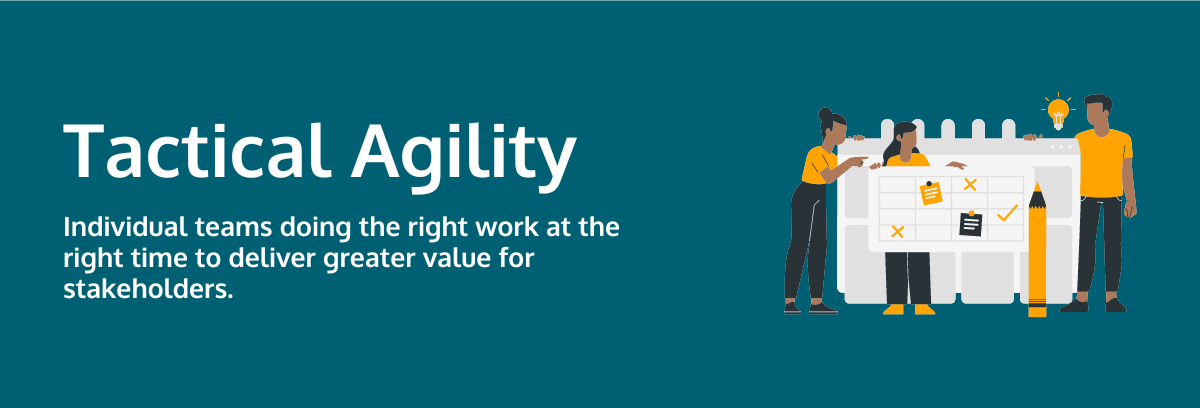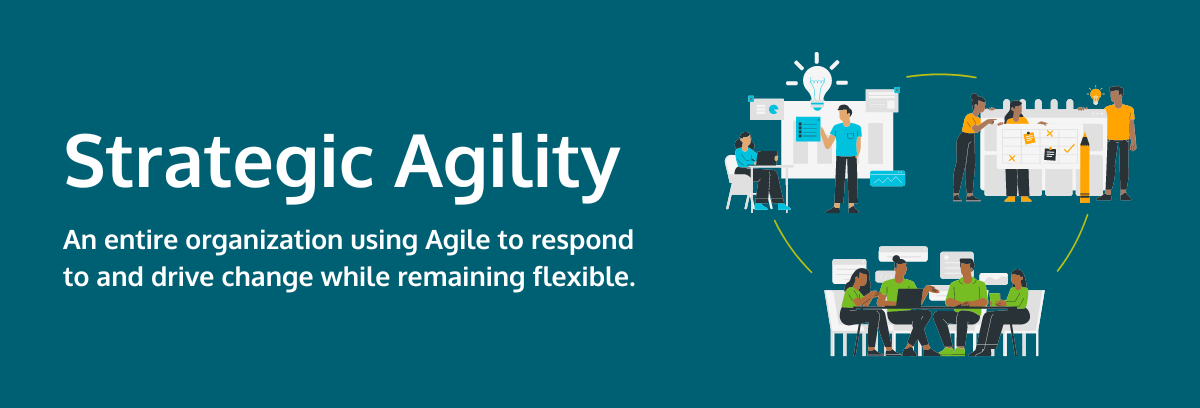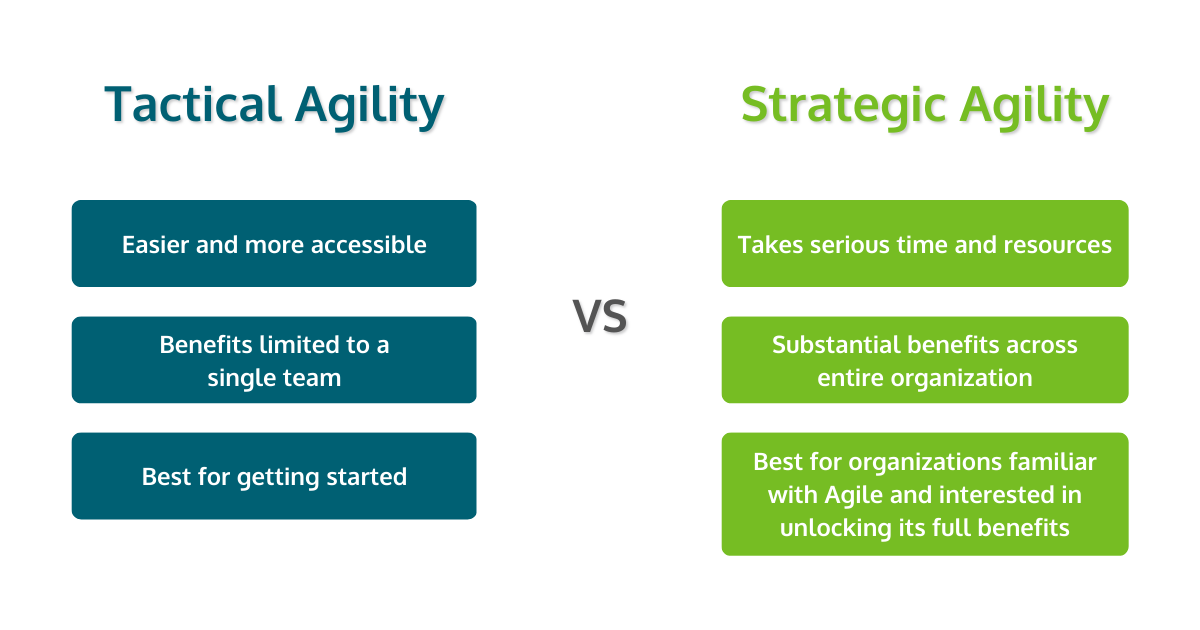Improve your Marketing Ops every week
Subscribe to our blog to get insights sent directly to your inbox.
Confront your process problems head on with a Sherpa by your side.
Explore support options that are tailored to meet you wherever you are on your climb.
Browse our pioneering Agile marketing courses
Learn from the stories of marketers already on the road to process improvement.
Featured Resource

State of Agile Marketing
Learn from 8 years of study on how marketers are increasing their agility.
Download Report
For all its benefits (and there are many), Agile can get a little hard to understand at first glance. You’ve got Agile for specific functions, Agile frameworks, Agile principles, etc.
But one of the most fundamental differences you need to understand from the start is strategic agility vs tactical agility. This knowledge will help you determine how best to approach Agile based on your organization’s specific needs and capabilities.
Luckily, the differences aren’t as complex as they may seem at first. So let’s jump in and learn how you can approach Agile for the best results.

Tactical agility focuses on improving on helping teams do the right work at the right time to deliver greater value for their stakeholders. Instead of simply accepting whatever work is assigned by those stakeholders, teams empowered with tactical agility will work with them to determine what is possible and will maximize value.
Thus, it’s a team-level approach that doesn’t necessarily require substantial changes in how other teams or more senior leaders in the organization operate. However, it does necessitate some give and take between teams and their stakeholders.
Overall though, tactical agility is far more accessible than strategic agility. While Agile transformations necessary to unlock the full potential of strategic agility usually take a year or more, implementing tactical agility on the team level is far more manageable as a first step in your Agile journey.
Also be aware that some define tactical agility slightly differently, focusing on whether the person leading the implementation is an in-house Agile expert or a dedicated trainer/coach. But we find that the distinction we’ve laid out is a far more useful way to think about Agile on the tactical vs strategic level.
Tactical agility can easily sound abstract, so let’s run through an example to understand what it looks like in practice.
Let’s say your organization has a marketing team that uses Scrum to manage their work. At the beginning of each sprint, they would meet with their stakeholders to determine what the main priorities are and how much work they can reasonably accomplish during that sprint.
Instead of having stakeholders assign work to the team ad hoc, requiring the team to frequently change focus, this enables them to be far more careful about ensuring the work they do has the maximum impact. It also enables the team to use capacity planning to avoid taking on too much work, ensuring that if an emergency occurs they can quickly respond.
The result? A team that is not overburdened is able to deliver more value and knows that its work is genuinely adding value. That’s a recipe for a productive and content team.

If tactical agility is all about the ability of individual teams to use Agile, strategic agility is about an entire organization’s ability to do the same. An organization using strategic agility is better able to quickly and appropriately respond to, or drive, change while maintaining flexibility and focus.
As a result, all of the benefits which teams can unlock using tactical agility are scaled and multiplied across the entire organization. In part, this is because Agile teams prefer working with other Agile teams as it enables them to more easily communicate and work the way they want without running into silos and roadblocks in other areas of the organization.
When organizations unlock strategic agility, they are able to both create Agile roadmaps that they can easily align the entire organization around. Rather than being a purely top-down affair, strategic agility enables leaders to create such plans in a collaborative way that takes both their strategic priorities and the experience and capabilities of their teams into account.
All of this results in plans that are more realistic, effective, and have greater buy-in and alignment from every part of the organization. Then, when circumstances change, those plans are adaptable. It’s no wonder strategic agility remains a goal for so many businesses today.
Considering how many businesses today are worried about how a potential economic downturn might affect them, let’s take an example of how strategic agility can help.
Let’s say you’re running a Software-as-a-Service (SaaS) company and the economy starts falling into recession. Instead of simply cutting costs by laying off employees, reducing the marketing budget, etc. your Agile teams can look at the new circumstances and reevaluate what actions will bring the greatest value.
All your teams can harness the Agile culture of experimentation and continuous improvement to find more efficient ways to use limited resources. If competitors are slashing marketing and providing a worse customer experience due to layoffs, this enables you to uncover ways to take advantage.
As the results from those experiments filter up to senior leaders, they can use those insights to rework the broader business strategy. Because you have strategic agility, the organization is then better able to take that new strategy and the insights behind it and incorporate them throughout the organization.
In other words, experimenting, making better use of limited resources and quickly shifting priorities all enable your SaaS company to thrive when competitors may struggle.

While strategic agility brings far more benefits, it’s also far more difficult to achieve. To have the best chance of successfully implementing the kind of Agile transformation needed to do that, it’s best to begin with piloting one or more teams in using tactical agility.
Those teams can then serve as places to test ideas, as well as a way to build up a core of Agile experience and knowledge which can then be used in an Agile transformation. Another way to understand how to approach this question is by examining the difference between Agile adoption and Agile transformation.
The first step towards achieving either tactical or strategic agility is a strong foundation in business agility fundamentals. This is what will enable you to forge leaders who can apply Agile principles to solving your most difficult challenges.
Our Business Agility Fundamentals Course is specifically designed to do just that. In it, you’ll work with seasoned coaches who have helped lead successful Agile initiatives in a variety of organizations. Their knowledge and experience will prepare you to meet your toughest challenges and thrive when your competition flounders.
Subscribe to our blog to get insights sent directly to your inbox.
Subscribe to our blog to get insights sent directly to your inbox.